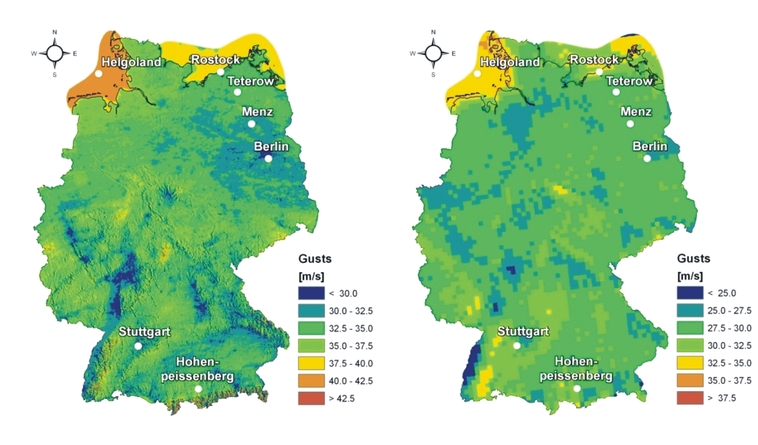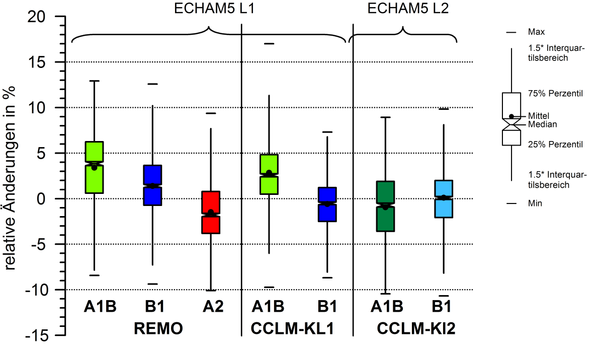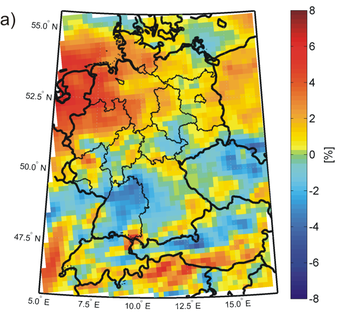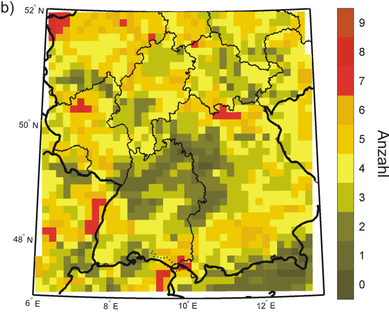RESTER / Strategies to reduce the storm risk of forests
- Contact: Dr. M. Kunz
- Project Group: IMK-TRO
- Funding: Ministry of the Environment, Nature Conversation and Transport of the federal state of Baden-Württemberg, Zukunftsoffensive IV

The joint research project RESTER (strategies to reduce the risk of storm damage for forests) is funded by the federal state of Baden-Württemberg within the framework of the program “Herausforderung Klimawandel”. It is aimed at investigating changes in the regional storm climate related to climate change.
Overview
Maximum gust wind speeds are quantified from the Regional Climate Models (RCM) of REMO (runs on behalf of the Federal Ministry for the Environment) and CCLM (consortial runs and own IMK runs calculated by the IMK-group “Water Cycle and Climate Modeling”). The different model runs were driven by different realizations of the global model ECHAM5 for the emission scenarios A1B, B1 and A2. The spatial resolution of the model data ranges from 18 to 7 km. By applying extreme value statistics, gust wind speeds as a function of the probability (or return period) are determined at each grid point. Expected changes in the gust wind speeds are calculated as the relative differences between the projection period PRO (2021 - 2050) and the control period C20 (1971 - 2000).
Validation of the results of the regional climate models
A comparison with the results of the CEDIM storm hazard map and additional observations confirmed that all climate models more or less are able to reproduce extreme wind speeds with low probabilities. This applies also to the tail and the skewness of the distribution function, which is a characteristic feature of extremes. However, it is found that all RCM simulations substantially underestimate the gust wind speeds. For example, for a return period of 10 years, the simulation results are between 10% (REMO) and 30% (both CCLM runs) lower compared to the observations. Reasons for the bias are still insufficient spatial resolutions of the models and weaknesses in the gust parameterization scheme. On the other hand, the spatial distribution of the velocities, especially the maxima over the low mountain ranges, the Alps and the ocean, is well reproduced. When considering relative differences between two time slices, systematic deviations are mitigated to a large extent.
Gust wind speeds for a 10-year return period according to the storm hazard map from CEDIM (~1 km x 1 km) and REMO (~10 km x 10 km). Note the different color scales.
Future projections of the storm climate
The individual model runs show different results for the relative changes in the gust wind speeds, which are mainly determined by the driving global model and its realization and, to a lesser extent, by the particular emission scenario. While almost all models expect an increase over Northern Germany, the signal for central and south Germany is not uniform. The spread of the results imply that it is not reasonable to consider only one single model to quantify climate change signals. Rather, the large number of possible realizations of the future climate should be considered by using a high number of different model runs. Such an ensemble also makes it possible to estimate the robustness of the change signals including statistical uncertainty.
An ensemble was created from all available RCMs with a resolution below 20 km. This ensemble comprises different emission scenarios, different regional models as well as different realizations of the global model. Hence, this ensemble covers a wide range of possible realizations. Two larger contiguous areas can be identified, where the majority of the model runs corresponds quite well. Over northwest Germany, the ensemble mean expects an increase in gust speeds for a 10-year return period between 2% and 8% with a probability of approximately 85%.
Boxplots of the relative changes in the gust wind speeds between PRO and C20 for a 10-year return period according to seven regional models. Only grid points between 47° N - 55° N and 5,5° E - 15,5° E are considered.
Relative changes in the gust wind speeds for an ensemble of seven regional climate models between C20 and PRO for a 10-year return period (a) and number of model runs (9 in total) that project an increase in the gust wind speeds (b).
Regional storm climate over Baden-Württemberg
For the federal state of Baden-Württemberg, the results of the climate projections are relatively robust with a slight decrease in the gust wind speed. Following the ensemble mean, the change of the 10-year gust speed is between -4% and +2.5% with a median of -2%. Only about 10% of the grid points located in the Rhine Valley and the northeastern shore of Lake Constance show a slight increase. As the standard deviation is relatively low and most of the model results agree well, this result can be considered as relatively robust. The decrease in storm activity over the northern parts of the state is confirmed by 7 or 8 of the 9 model runs available.
Publications
Mayer, H., Schindler, D., Kunz, M., Ruck, B., 2010: Strategien zur Reduzierung des Sturmschadensrisikos für Wälder (Verbundprojekt RESTER), Programm Herausforderung Klimawandel Baden-Württemberg, Berichte des Meteorologischen Instituts der Albert-Ludwigs-Universität Freiburg, Nr. 21, 148 S.
Mohr, S., 2008: Änderungen der Häufigkeit und Intensität von Winterstürmen in Deutschland auf Grundlage regionaler Klimasituationen. Diploma thesis, Institute for Meteorology and Climate Research (IMK-TRO), KIT, 97 pp.
Kunz, M., S. Mohr, M. Rauthe, R. Lux, and Ch. Kottmeier, 2010: Assessment of Extreme Wind Speeds from Regional Climate Models. Part I: Estimate of Return Values and their Evaluation. Nat. Hazards Earth Syst. Sci., 10, 907-922, DOI: www.nat-hazards-earth-syst-sci.net/10/907/2010/.
Rauthe, M., M. Kunz and Ch. Kottmeier, 2010: Changes in storm climatology over Central Europe derived from a small ensemble of high resolution regional climate models. Met. Z., 19, 299-312, DOI:10.1127/0941-2984/210/0350.




